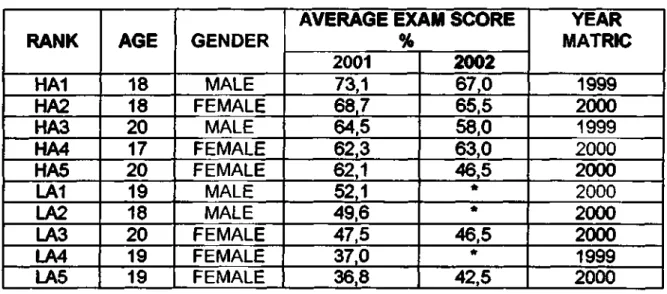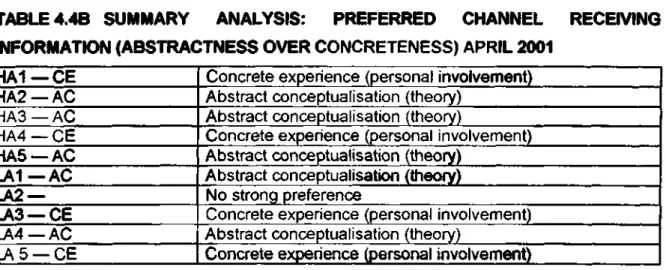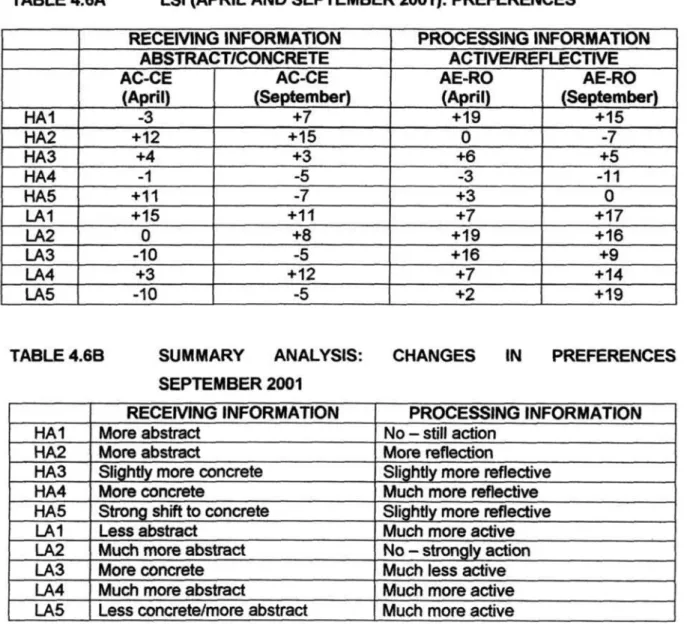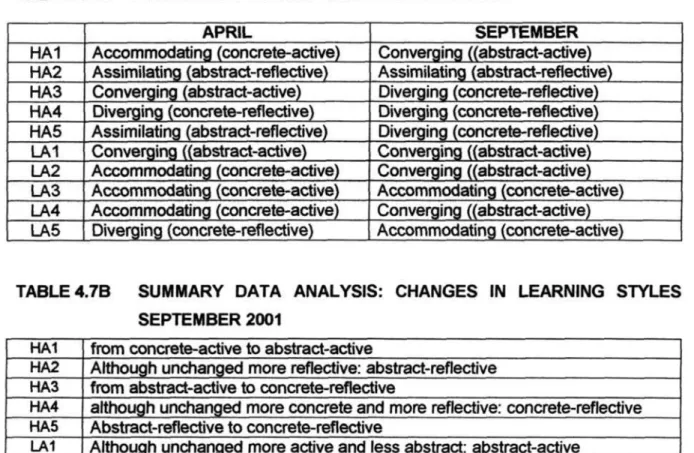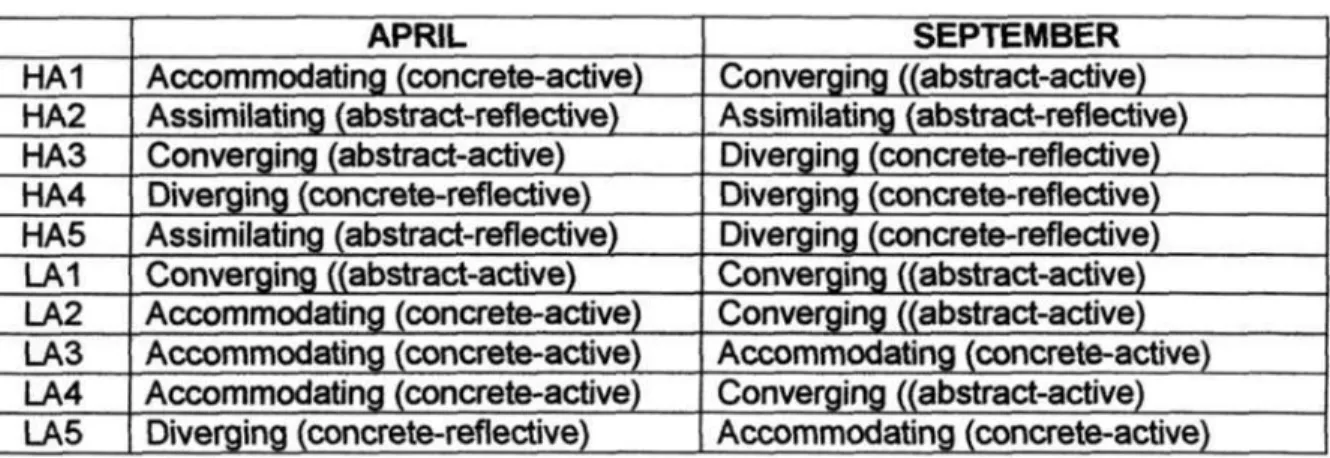APRIL 2001 71 TABLE 4.5A LSI (APRIL 2001): INFORMATION PROCESSING (PREFERENCES. ACTION OVER REFLECTION) 73 TABLE 4.5B SUMMARY ANALYSIS: PREFERRED CHANNEL PROCESSING. INFORMATION (ACTION ON REFLECTION) APRIL 2001 73 TABLE 4.6A LSI (APRIL AND SEPTEMBER 2001): PREFERENCES 74 TABLE 4.6B SUMMARY OF ANALYSIS: CHANGES IN PREFERENCES.
BACKGROUND TO THE STUDY
The student 'at risk' and the academic literacy course are discussed in the next two sections (1.2 and 1.3). In 2001, the institution defined as a 'risk' student a first-year degree student who did not meet the institution's requirements regarding knowledge of the English language.
USING THE ACADEMIC LITERACY COURSE AS A CASE STUDY
Some of the students who participated in the academic literacy course in 2001 are the subject of this research. Ten 'at risk' students in this Academic Literacy course in 2001 constitute the case study and research sample.
FOCUS OF THE CASE STUDY
Five of the ten 'at risk' students were identified as high achievers (HA) and five as low achievers (LA) based on the average of three final exam scores (exams taken in 2001) in their regular education program National Diploma Retail Management (one of which was majoring in Retail Business Management 1 ). It is believed that this research provides potentially useful educational knowledge for 1) academic development professionals in the DIT; 2) the regular teaching staff of the DIT; and 3) the broader higher education academic development community. From the perspective of the researcher, as a practitioner of reflective academic development/academic literacy development, the research is seen as part of an ongoing process of reflection on one's own practice, with the aim of not only better understanding one's own practice, but also to improve.
RESEARCH QUESTIONS
This research is expected to provide potentially useful educational knowledge for 1) practitioners of academic development in DIT; 2) main teaching staff at DIT; and 3) the broader higher education academic development community.
STRUCTURE OF RESEARCH REPORT
INTRODUCTION
THE RELATIONSHIP BETWEEN LANGUAGE AND LEARNING
It may be necessary to simultaneously develop competences in the English language and the language of the profession. This is therefore a problem in acquiring the language of economics (a problem in acquiring academic literacy) and may not be related to the student's communicative competence in English.
LEARNING USING ENGLISH AS A SECOND OR ADDITIONAL LANGUAGE
In terms of Cummins' model (discussed in the next section), these schools have failed to move students into the CALP quadrant (see Figure 2.1 below), that is, these students are not capable of being 'cognitively demanding' manipulate and interpret context-reduced text'. (Cummins, 1984: 142). Furthermore, if there are no contextual cues to facilitate comprehension, the task is perceived as cognitively demanding and context-reduced.
LEARNING
A deep understanding of learning is considered in this study to be related to the conception of learning as 1) understanding;. These poles are used in combination to determine the learning style that students have at a particular stage of their development (see quadrants 1–4 in Figure 2.2 below).
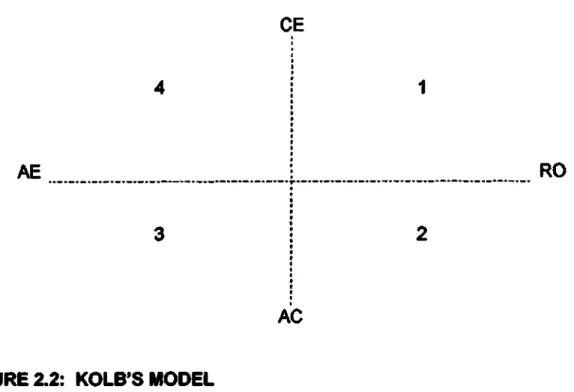
CONCLUSION
Purdie et at's (1996) research identified a relationship between a student's use of these self-regulated learning strategies and academic performance. High achievers are associated with displaying significantly greater use of thirteen of the fourteen strategies (Purdie et al.
INTRODUCTION
THE NATURE OF EDUCATIONAL KNOWLEDGE, ASSUMPTIONS AND RESEARCH PARADIGMS
The researcher has a practical interest, that is, he is looking for a contextualized understanding of 'at-risk' students. He has a 'practical interest' in at-risk students, that is, the researcher's intent is to make sound judgment through contextualized understanding.
TRUTH AND VALIDITY
If the report is situated in the research conversation, the writer makes clear the debates that have influenced his/her thinking. Does the account offer some thoughts on “So What?” How has the work influenced the way the writer goes about his or her professional work?
CASE STUDY RESEARCH
QUESTIONNAIRES Student Learning Survey (SLS)
This may have influenced the data and must be taken into account in the data analysis and in any conclusions. This limitation must be taken into account when doing the data analysis and when drawing conclusions.
STUDENT RECORDS
CONCLUSION
DATA ANALYSIS
INTRODUCTION
On the other hand, a deep understanding of learning (or meaning orientation) would be related to a conception of learning as 1) understanding; 2) the concept of meaning and the formation of meaning; 3) to see something in a different way or expand the view; and 4) changing as a person (Sitoe, 2000). A deep (+) would indicate a strong deep learning perception and a deep (-) would indicate a weak deep learning perception. The overall picture suggested by these data is that most of the 'at-risk' students in the study probably have a superficial understanding of learning.
Although deep perceptions exist (and more so among HA students) and are emerging, no student in the study shows evidence of a deep (+) perception of learning.
AT RISK' STUDENTS' INCIDENCE OF DEEP AND SURFACE LEARNING
The low scores on the AO (achieving orientation) scale suggest that no "at-risk" students use a deep-achieving or a surface-achieving approach to learning. It was expected that the HA group would have scored better on the AO scale than the LA group. The students' responses to the AO scale warranted further investigation to find a possible explanation for the low scores on this scale.
The HA and LA group of 'at risk' students (except HA2) have high scores on these reverse scored items (negatively scored) and they range from 7 to 15 (see Table 4.5 below) and this explains these students' low score on the AO weight.
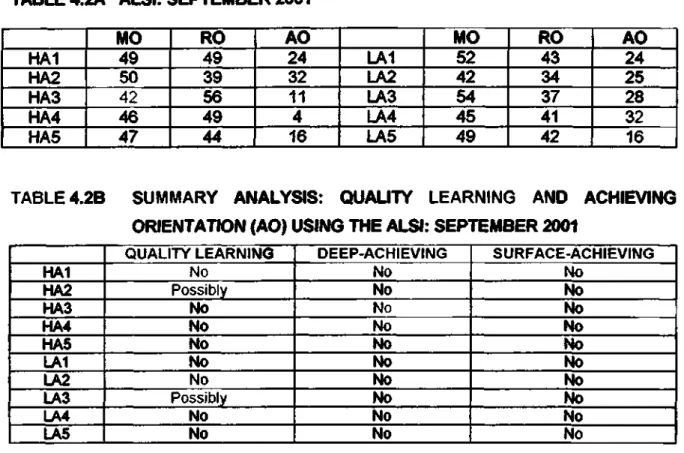
AT RISK STUDENTS' LEARNING STYLES
- RECEIVING INFORMATION
- PROCESSING INFORMATION
- CHANGES IN LEARNING STYLES: PREFERENCES RECEIVING INFORMATION (ABSTRACTNESS OVER CONCRETENESS) AND PROCESSING INFORMATION
- USE OF SELF-REGULATING LEARNING STRATEGIES
A conclusion is that there is no evidence of a dominant preferred channel (abstractness over concreteness) among HA and LA 'at risk' students when receiving information. The analysis of the data focused on 1) the self-regulatory learning strategies (that is, metacognition) that students 'at risk' used to plan and write an academic essay (item 2.1 in. The aim of the analysis is to to judge 'at risk' students' level of metacognitive knowledge and metacognitive awareness when doing selected tasks.
Each student's response is recorded and then analyzed following similar procedures (see Appendix A.4) The purpose of the analysis is to examine the level of metacognitive knowledge of the student 'at risk' when preparing for a short test.. tutorial and make a judgment of whether the strategies can help the learner learn and remember.

CONCLUSION
Summary analyzes of the data (in Tables 4.2A and 4.2B) show that the 'at risk' students in the study do not exhibit quality learning (a high meaning orientation and a low reproduction orientation) and none of these students endorse an achievement deep or a surface approach to learning, that is, all at-risk students in the study have a low achievement orientation. When examining learning styles (using Kolb's instrument), summary data analysis (in the April data) shows that no predominant preferred channel is used when receiving information (Tables 4.4A and 4.4B) (abstract or concrete). The summary data (Tables 4.5A and 4.5B) show that action is the preferred channel used during information processing, rather than reflection.
Over time, although the students seem to make changes in channels used when processing information (Tables 4.6A and 4.6B), some have become more reflective and others less active (and vice versa).
INTRODUCTION
FINDINGS
There is also a suggestion in the study that key factors possibly influencing 'disadvantaged' students' perceptions of learning are linked to socialization (schooling and social class) and to competence and opportunities to use the English language (competence in BICS and CALP ). High-achieving "at-risk" students are more likely to have experienced better school quality (wherever those schools may be). This finding arising from the study is somewhat speculative and further research is needed to confirm these associations.
LIMITATIONS IN THE STUDY
The researcher could cross-check his interpretations of 'at-risk' students' questionnaire responses through greater use of individual interviews, focus group interviews and classroom participant observations. The use of these methods would 1) increase the validity of the study 2) allow for less tentative subjective interpretation and 3} improve the justification of the recommendations. The researcher could better take advantage of the opportunities: 1) to closely observe and record the learning behavior of 'at-risk' students, given that he was a lecturer in an academic literacy course 2) to examine the outcomes of an academic literacy course in depth and critically. and consider its role in facilitating deep learning and metacognition 3) critically and critically examine the role of "mainstream" .. courses and lecturers in shaping learning styles, metacognition and academic literacy acquisition and 4) critically and critically examine samples of student writing taken from a variety of courses in the regular stream of 'at risk' students.
Further limitations in the study have to do with 1) the difficulty of making inferences based on large amounts of quantitative data without evidence from other types of qualitative data (for example interviews) 2) the small sample that the .. the ability to make useful generalizations 3 ) the answers to the open questions may not have been sufficient to generate categories and insights 4) in closed answers the students may feel they have to give answers to satisfy their lecturer / researcher.
RECOMMENDATIONS
A possible recommendation from the study is to abandon the use of a separate Academic Literacy course to develop 'at risk' first year of study DIT higher education students and instead integrate the development of deep learning. However, this recommendation has clear implications for both curriculum development and staff development in higher education. The study also provides evidence that some first-year students may be so unprepared for higher education that they should not be admitted to the DIT.
Access to and success in higher education in general and in DIT in particular.
POSSIBILITIES FOR FURTHER RESEARCH
It is argued that LA2 has a surface perception of learning and possibly deep perceptions that emerge. LA3 has a narrow view of learning as only about increasing knowledge, and this suggests a superficial view of learning. She views learning narrowly as only about increasing knowledge and memorization, a surface view of learning.
When compared to April (2001), HA1 made no significant change in his deep (-) perception of learning. This limited metacognitive behavior is related to her superficial (-) perception of learning diagnosed in Table 4.2. These metacognitive strategies can improve learning for the end-of-semester test and confirm his deep (-) perception of learning (Table 4.2).
NAME; STUDENT NO, DATE
3 should only be used if you find it impossible to give a certain answer 2 means you slightly disagree (you disagree to some extent).
STATEMENTS
- PLATO
- FILE for assessment, which has in it, your academic literacy work for the academic year and the tests you have completed in your educational
- QUESTIONNAIRES
- FINAL INTERVIEW (FOURTH TERM)
HA3 has a relatively low score of 42 on the MO scale (a low incidence of deep learning) and a very high score of 56 on the RO scale (a high incidence of surface learning) and this suggests that quality learning it is not developing. She has a very low score of 4 on the AO scale and this indicates a very negative attitude, inefficient use of study methods and is not motivated to achieve. She has a low score of 16 on the AO scale and this indicates a negative attitude, inefficient use of study methods and that she is not motivated to achieve.
The score of 24 on the AO scale is relatively low and this indicates a negative attitude, inefficient use of study methods and that he is not motivated to perform.
